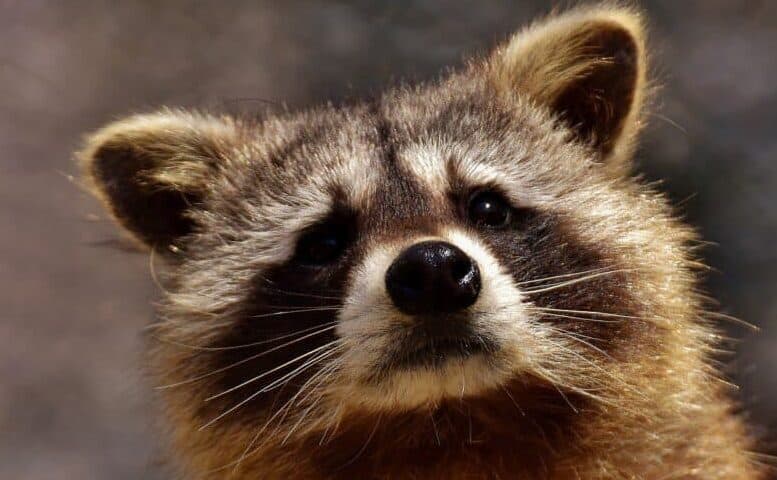
You have likely seen raccoons in your neighborhood or even wandering the Galaxy. We will profile this masked bandit, so you’ll know the facts.
The raccoon is widely found through North America and parts of Europe and Japan. Because of its intelligence, omnivorous diet, and adaptability it can live in cities, suburbs, woodland and wetlands. Raccoons can carry some diseases including rabies so they are a potential threat to pets.
Let’s continue on and learn more about this crafty critter, its history, some fun facts and what makes it able to survive so well.
What is the origin of the name Raccoon?
Although Christopher Columbus was the first person to write about raccoons, English settlers had never seen a real raccoon before arriving in North America in the 1600s. When asking members of the Powhatam tribe what they were, it was explained that they were called “arahkun” which means “animal that scratches with its hands”. The English settler’s version, based on the Powhatam name, became “arocoun”, which morphed over time to raccoon.
The scientific name for a raccoon is Procyon lotor, which translates from Latin as “before dog washer”, relating to the habit of raccoons to seem to wash their food. Raccoons are part of the family Procyonidae which includes coati and ringtails which are found in the southwest United States and through Mexico and central American to northern regions of South America.
FUN FACT – Male raccoons are called boars, and females are called sows. Baby raccoons are called kits, and a group of raccoons is known as a gaze or a nursery.
What are the raccoon’s physical features?
Raccoons can range in size from 16 to 28 inches (head and body) with a tail that can be 6 to 16 inches long. A raccoon’s height, measured at the shoulder can be between 9 and 12 inches. An adult raccoon will normally weigh from 5 to 30 lbs. Males can weigh 20 to 40% more than female raccoons.
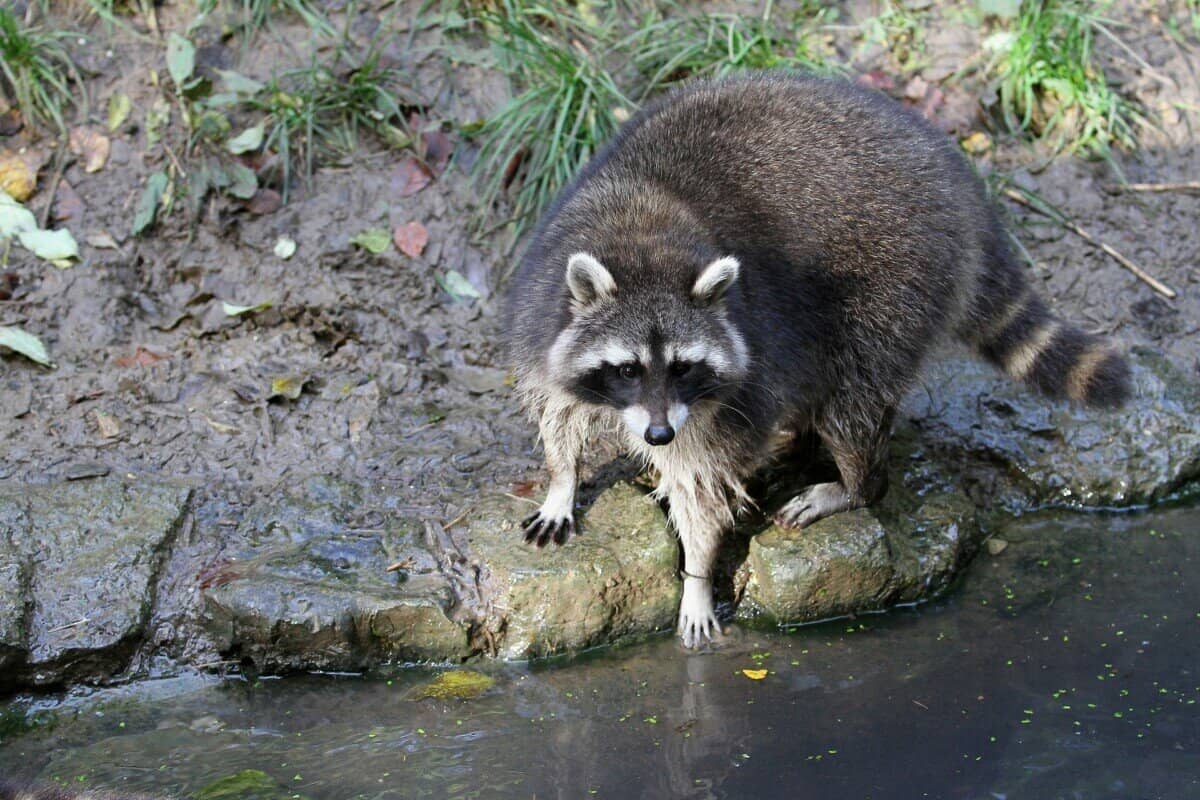
Raccoons that live in warmer climates, such as the southern U.S. and central America tend to be smaller than their cousins that live in climates that experience winters. Raccoons in the Florida Keys are typically only weigh 5 to 8 lbs.
Raccoons are known for their dark mask and ringed tail, which lends to nicknames such as masked bandit. Their fur is described as grizzled and varies from gray to black. In winter a yellowish or reddish color may develop on the fur over the neck. Males and females have similar color fur.
A raccoon’s sense of touch is very important and is highly developed in the forepaws and the tip of the nose. They will explore with their paws, looking for food, or sensing vibrations around them, on the lookout for danger. Their paws have five toes each with no fur. Raccoons are very dexterous and can rapidly climb a tree or pull food towards themselves.
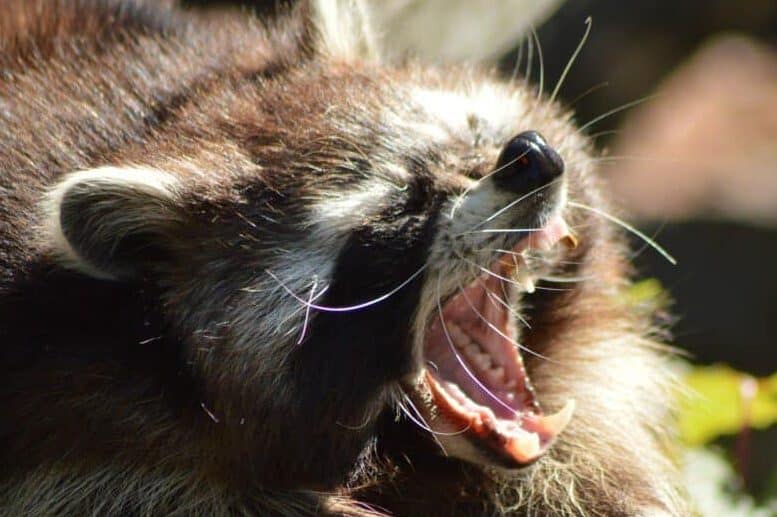
Raccoons are omnivorous and have teeth that allow them to take advantage of food that is available. They have canine teeth for ripping and tearing and molars for grinding. They have 40 teeth in total, laid out very much like the teeth of a dog, but with two less molars on the bottom row of teeth.
Like many nocturnal animals a raccoon’s eyesight isn’t its strongest sense. They have relatively poor distance vision and are color blind. But they do have good sensitivity for light intensity. If you happen to meet a raccoon out at night and you have a flashlight, you will see a reflection from the back of the raccoon’s eye, which can be yellow to green. They have a membrane behind the retina which reflects light back to light sensitive cells in the retina, the scientific name for this membrane is the tapetum lucidum.
While wild animals certainly use their sense of hearing to avoid danger, the raccoon has been found to have hearing that is comparable to cats. Hearing an approaching threat will prompt a raccoon to climb a tree to safety or move away from the sound.
What do racoon tracks look like?
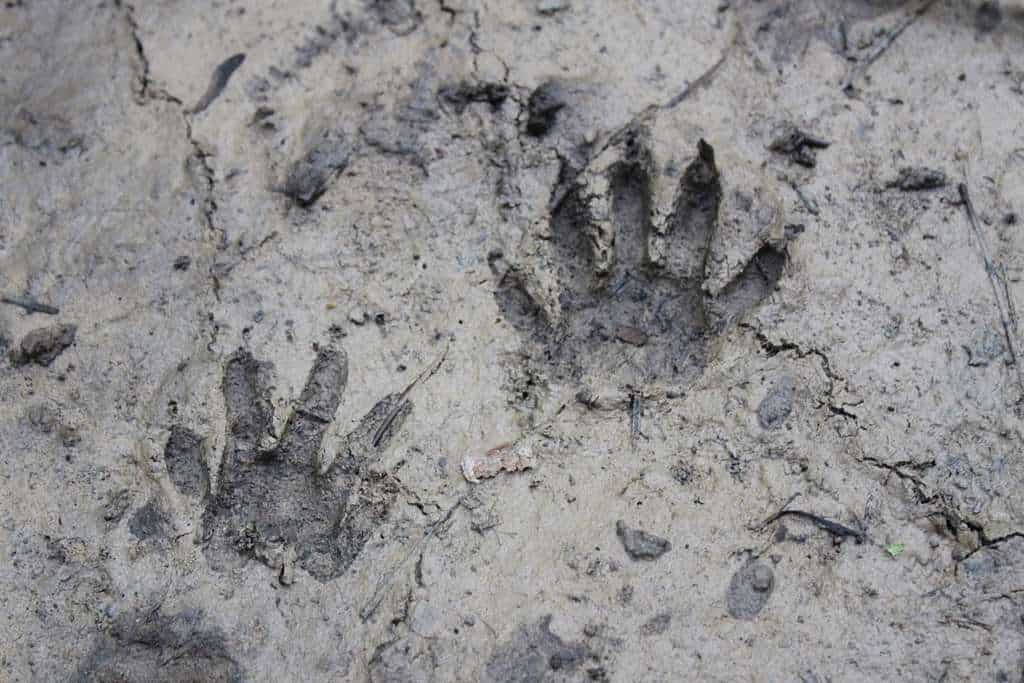
Raccoon tracks will show the bare five-digit paw prints. The size of each print can be between 1 ½ to 3 inches in length. The rear paws or more elongated and will be slightly larger. Because of the way that they walk, their gait, the tracks from front and rear paws will be next to each other.
Where are raccoons found?
Originally raccoons were native to North America, and were spread widely in woodland areas, damp areas such as wetlands, and around water sources. Raccoons can be found in nearly all 50 states except for parts of the Rocky Mountains, and southwestern states like Nevada, Utah, and Arizona. .
In the 20th century, raccoons spread through Europe and Japan. They were introduced in Germany in the 1920s to be raised for their fur and they were also released into the wild. Raccoons were imported into Japan during the 1970s based on the popularity of an anime cartoon series Rascal the Raccoon. Maintaining raccoons as pets does not work well as they are wild animals and Japanese racoon owners found themselves releasing their pets as they became destructive as adult animals.
Because of their adaptability, raccoons are now commonly found living in suburban and in some cases urban areas where food is easier to find. Exact population numbers are unknown, but they are likely to be very high. For instance, in wet lowland areas, it is estimated that raccoons have a population density of about 150 per square mile. In forested or agricultural areas, there are approximately 60 per square mile.
Raccoons are not territorial as long as there is sufficient food. They are typically solitary, but may be seen in groups of over ten, especially around dens.
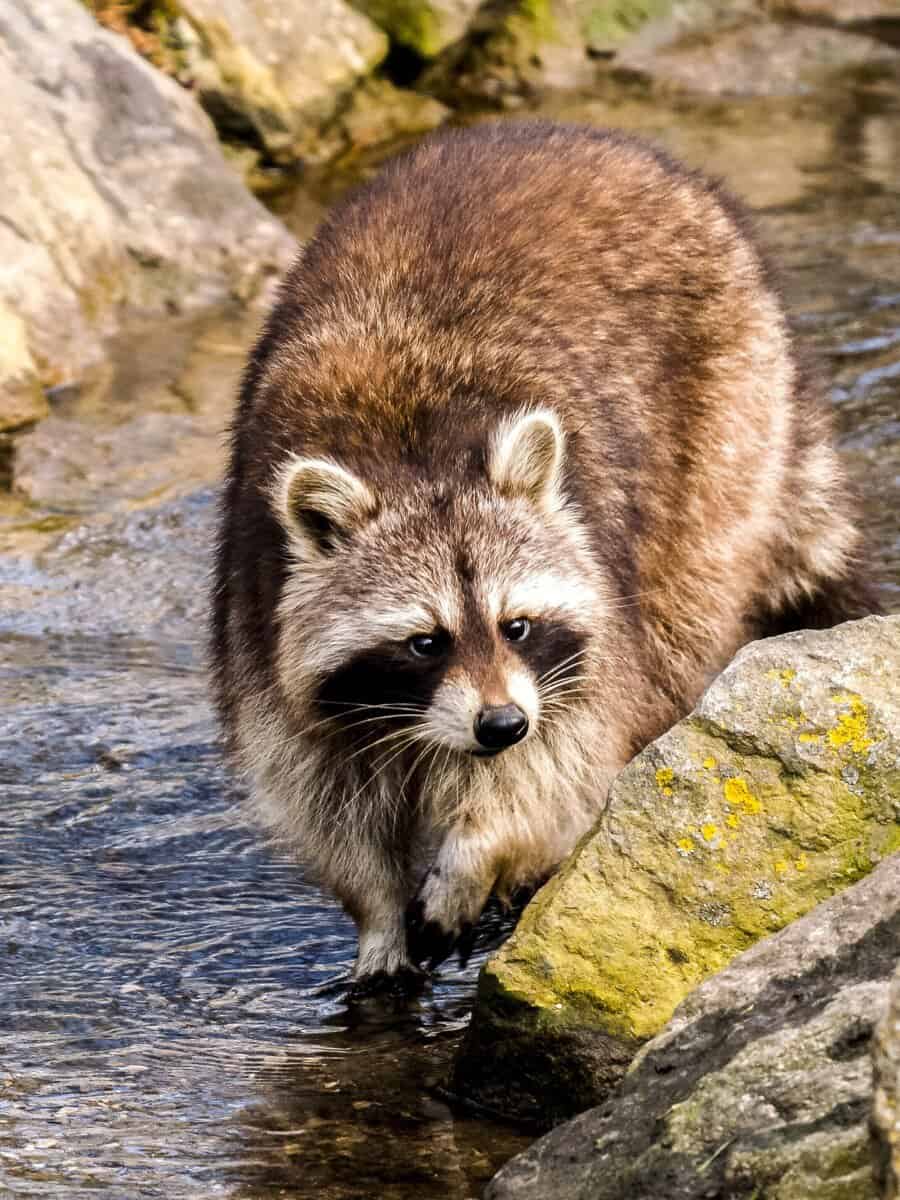
What do raccoons eat?
Raccoons are omnivores, which means they eat both meat and plants. Small animals like frogs, fish and crawfish are prized, but their main diet consists of plant foods like berries or nuts. Among plant foods, they also love corn and are well known for raiding cornfields.
They are opportunistic and will take advantage of found sources they find. In suburban and urban areas, they will root through garbage or eat dog or cat food that is left outside. Raccoons will eat between 5 and 10% of their body weight daily when food is readily available.
In the summer and fall raccoons will eat as much as possible to build up stores of fat, which is how they survive winter months. A raccoon may use 50% of its fat to make it through a winter.
Do raccoons wash their food?
Many people believe that raccoons do wash their food, but when they are near water and dunk food in water it actually helps them feel the food better, rather than making the food cleaner. Their sensitive paws are well tuned for finding food around ponds and rivers.
How to Identify Raccoon Droppings (Scat)?
Because raccoons eat many different things, their droppings, also called scat, may change depending on the season. When fruit is available, you may see undigested seeds. If the diet has small animals, the fur or bones that were eaten may be visible. Typically you will see cylindrical pieces in a small pile.
Where do Raccoons Live?
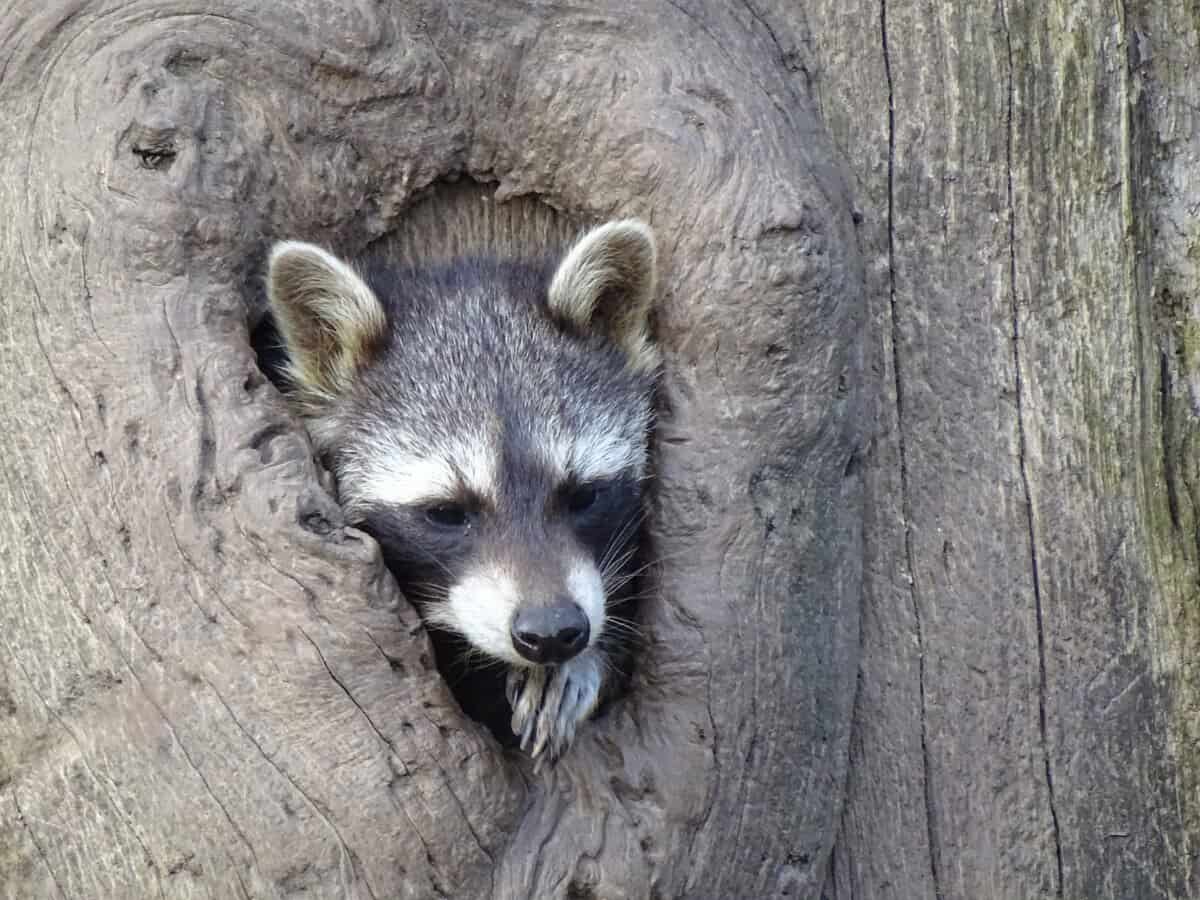
Because raccoons often live near areas with trees, nests or dens can be found in the hollows of trees. But they will also live in burrows and may even move into the abandoned den of a woodchuck. When living around people, raccoons can unfortunately get into attics, or build dens under a deck.
This is an important issue, because raccoons can create property damage by chewing through building materials to gain access to an area of a home or garage, that provides them with protection from the weather and other animals. And it offers a place for giving birth to their young.
Grooming
Raccoons groom their fur in a similar way to cats. If a den is shared by more than one raccoon, grooming of the other animal may provide a way for diseases or parasites to be transferred.
When are raccoons most active?
Raccoons are nocturnal animals, so they are most active at night. Often with dawn and dusk being very active times. In the summer and fall they may start out just after sunset to forage for food, and then spend time exploring their territory. In the fall, they are more focused on food, to build up fat stores for the winter. Once winter arrives, the time outside of the den is reduced. They may spend shorter amounts of time looking for food just after sunset, but return to the den for warmth and to save energy.
Do raccoons hibernate?
Raccoons do not hibernate like bears, but as mentioned, they do put on extra body fat to help survive the winter. During cold weather they may even stay in a nest for several days during the coldest weather. Raccoons may den together to help keep each other warm.
Do raccoons live in groups or alone?
Adult raccoons are generally solitary animals. They tend to lead independent lives, foraging for food and maintaining their own territories. Each raccoon typically has its own home range, which it defends against other raccoons of the same sex. Males and females generally come together only during the breeding season.
Do raccoons mate for life?
Raccoons are not monogamous animals. They are generally solitary in their adult lives and do not form long-term pair bonds with a single mate. Instead, their mating system is typically characterized as promiscuous or polygamous.
During the breeding season, which in the northern hemisphere usually occurs in late winter to early spring, male raccoons will seek out multiple female mates. They may compete with other males for access to receptive females, and a single male may mate with multiple females over the course of the breeding season. Once mating has occurred, there is no ongoing commitment or partnership between the male and female raccoons. The females are responsible for raising and caring for the young, typically in a den or nesting site.
How long is a female raccoon pregnant?
The gestation time for raccoons is normally about two months. It can vary deending on food and environmental conditions. In the wild, most young are born in May or June; however, mating can begin in January depending on the location.
How many babies does a raccoon give birth to?
Raccoons give birth to between 2 and 6 babies at one time, which are called kits or cubs. The average litter size is 3 babies, but can be between 1 and 6.
The mom raccoon builds a nest in which she will give birth and raise her young, usually in a tree cavity or den somewhere on the ground (raccoon dens can be found under porches). She makes this nest out of leaves, sticks, grasses–whatever materials she can find near where she lives! After giving birth, the mother cares for and raises her young in a den, providing them with milk and protection until they are old enough to venture out and explore on their own.
What happens to baby raccoons after they are born?
Raccoon kits are not born with fur. Newborn raccoons are typically born blind, deaf, and mostly hairless, with only a light, sparse covering of fine, short hair. Their eyes remain closed for the first few weeks of their lives.
Over the course of their first few weeks, raccoon kits gradually develop a thicker coat of fur, their eyes and ears open, and they become more mobile and aware of their surroundings. Their fur becomes denser, and their markings start to become more distinct as they grow older.
Raccoon kits start the weaning process at about 7 to 9 weeks old, during which they begin to transition to a diet that includes solid food. This is also the stage when they become more independent of their mother’s milk.
By 7 to 9 weeks of age, raccoon kits are typically more active and capable of exploring the world outside the den. They may start venturing out with their mother on nightly foraging trips and learning important survival skills. However, they still stay relatively close to the den and their mother for some time. As the kits continue to grow and develop, they become more independent from their mother over several months. They eventually disperse to establish their territories
What sounds do raccoons make?
Raccoons are known for their wide range of vocalizations. They can make a variety of sounds, including a barking noise, a low growl and even a high-pitched scream. The young also make a variety of sounds, including growls, chirps and whines as well as hisses and snarls when they’re angry or scared. Raccoon cubs will also bark at each other when playing or fighting over food.
How long do raccoons live?
Raccoons can live up to 15 to 20 years in captivity, but their lifespan in the wild can be as short as two to three years. A raccoon is near the top of the food chain, but may be attacked by coyotes, or larger cats such as cougars or bobcats. In urban and suburban areas, getting hit by vehicles and disease are the main risks.

